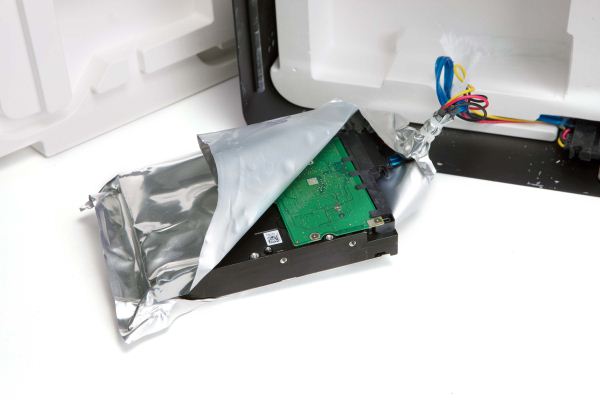ioSafe SoloPRO: Disaster Proofing Your Storage Needs
by Ganesh T S on April 9, 2012 6:00 PM EST- Posted in
- Storage
- IT Computing
- ioSafe
The SoloPRO consists of two pieces of steel which interlock and are held together with screws. Inside it is the DataCast (ioSafe's trade name) endothermic insulation (which was described in the last discussed patent). Since hard drives are comparatively low power (in the 5-20 W range), a hatchless design with no moving parts is used. The HydroSafe (again, ioSafe's trade name) barrier is the water resistant enclosure described in one of the inventions listed in the second patent. The photograph below shows the internals of the ioSafe SoloPRO. Note the two zip ties used to seal the wires going into the waterproof pouch.
We looked at the technology behind ioSafe's products in the previous section and had a look into the internals just now. But, how effective is the technology? Instead of subjecting the unit to fire and water damage, and just presenting readers with results which a number of other excellent reviews have already done, we decided to concentrate on covering the technology behind the unit. That said, we went through a large number of ioSafe videos on YouTube and decided to present one particular destruction / recovery attempt which, we believe, brings across the disaster proof nature of ioSafe's offerings in a realistic scenario. Embedded below is the video review of an ioSafe unit by GearDiary's Larry Greenberg
The above video also shows how to recover the data from an ioSafe unit subject to fire and water damage. In almost all cases, however, the users just need to mail the drive back to ioSafe for data recovery (and getting another ioSafe unit with that data).
There are other videos on YouTube showing how ioSafe's offerings stand up to various destruction attempts, and we believe there was nothing we could do in our testing that could one-up those professional destruction attempts.
Home users dealing with small amounts of data can always back up their contents using cloud services like Dropbox and Box.net. Serious businesses always have an off-site tape backup or some other similar mechanism for data backup. However, the former is not suitable for large amounts of data (say, more than a few hundred GBs), and the latter is not suitable for making a disaster proof copy of recently changed files. Keeping this in consideration, it is also necessary to evaluate the performance metrics of the unit.











34 Comments
View All Comments
Coup27 - Monday, April 16, 2012 - link
Hi Rob,It's nice to have a CEO, or even a company rep in these comments. I don't know if you are still checking these comments but if you are, is there a reason why there is no NAS version of this product? USB obviously has cable length limitations and if you wanted to secure the ioSafe somewhere on-site out of the practical reach of theft, the chances are it's going to be more than 5M away from my expensive server.
My company is only small, about 30 staff with 10 computer based users. Today I have spent longer "discussing" the my options for backing up my IT provider than I did talking about the actual server implementation and roll out. Every option we discussed had a pit fall and we were left with the classic and incredibly frustrating "2 x external drive shuffle alternating once a day/week by a member of staff who someone then takes home" [insert expletive here]
As has been mentioned already, cloud backup completely fails when backing up considerable data, especially large email repositories.
Regards
robb.moore - Monday, April 16, 2012 - link
Hi Coup27-At ioSafe we use a Synology NAS (RAID, NAS, Private Cloud, Etc) with an ioSafe SoloPRO as the backup target for the NAS using the eSATA port on the back of the NAS. This will allow you to place the ioSafe anywhere on the network (wired or wireless).
This works really well imo for the small business as there's no backup software to install on the clients if you're just after protecting the NAS. If you'd like to image the entire OS for the attached clients, you can either buy an ioSafe for each computer user and image it that way - reducing the data pushed across the LAN (this is what we do at ioSafe). Or you can image the user's hard drives across the LAN to the NAS which in turn backs up to the ioSafe (this is what I do for my home computers).
Additionally, you can layer in whatever offsite strategy you'd like if you feel you need it at this point.
We're also working on some other NAS solutions that we'll be announcing later this year. Hope that helps.
Robb Moore
CEO
ioSafe
Coup27 - Thursday, April 19, 2012 - link
Hi Robb,Unfortunately having to rely on a seperate NAS to add network capabilities adds a significant cost to a quite reasonably priced item.
When I can eventually afford my own house I would certainly consider a NAS ioSafe to place in my loft as a secure backup. This would be inpractical to be taken during a theft, and would survive water and fire damage. Obviously that would not include an off-site backup but I'm not sure how practical that is for a domestic user with TB's of data. I think a NAS ioSafe would be an excellent overrall solution and hope so see them soon!
Cheers
glugglug - Monday, March 4, 2013 - link
Can the ioSafe be opened up and the drive inside it replaced with a larger one?Will opening it break some seals required for the disaster proofing?